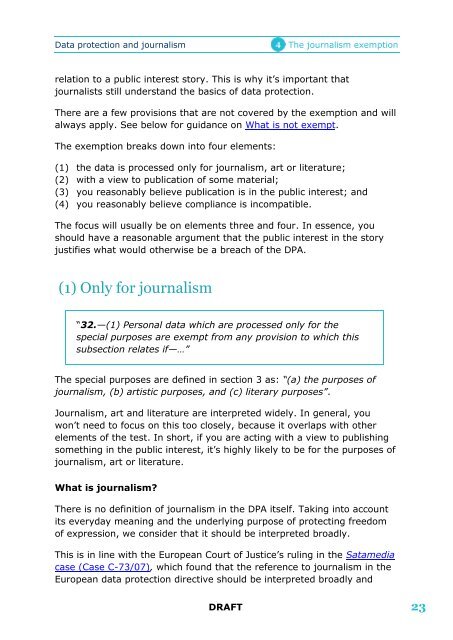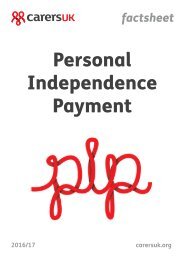data-protection-and-journalism-a-guide-for-the-media-draft
data-protection-and-journalism-a-guide-for-the-media-draft
data-protection-and-journalism-a-guide-for-the-media-draft
You also want an ePaper? Increase the reach of your titles
YUMPU automatically turns print PDFs into web optimized ePapers that Google loves.
Data <strong>protection</strong> <strong>and</strong> <strong>journalism</strong><br />
The <strong>journalism</strong> exemption<br />
relation to a public interest story. This is why it’s important that<br />
journalists still underst<strong>and</strong> <strong>the</strong> basics of <strong>data</strong> <strong>protection</strong>.<br />
There are a few provisions that are not covered by <strong>the</strong> exemption <strong>and</strong> will<br />
always apply. See below <strong>for</strong> guidance on What is not exempt.<br />
The exemption breaks down into four elements:<br />
(1) <strong>the</strong> <strong>data</strong> is processed only <strong>for</strong> <strong>journalism</strong>, art or literature;<br />
(2) with a view to publication of some material;<br />
(3) you reasonably believe publication is in <strong>the</strong> public interest; <strong>and</strong><br />
(4) you reasonably believe compliance is incompatible.<br />
The focus will usually be on elements three <strong>and</strong> four. In essence, you<br />
should have a reasonable argument that <strong>the</strong> public interest in <strong>the</strong> story<br />
justifies what would o<strong>the</strong>rwise be a breach of <strong>the</strong> DPA.<br />
(1) Only <strong>for</strong> <strong>journalism</strong><br />
“32.—(1) Personal <strong>data</strong> which are processed only <strong>for</strong> <strong>the</strong><br />
special purposes are exempt from any provision to which this<br />
subsection relates if—…”<br />
The special purposes are defined in section 3 as: “(a) <strong>the</strong> purposes of<br />
<strong>journalism</strong>, (b) artistic purposes, <strong>and</strong> (c) literary purposes”.<br />
Journalism, art <strong>and</strong> literature are interpreted widely. In general, you<br />
won’t need to focus on this too closely, because it overlaps with o<strong>the</strong>r<br />
elements of <strong>the</strong> test. In short, if you are acting with a view to publishing<br />
something in <strong>the</strong> public interest, it’s highly likely to be <strong>for</strong> <strong>the</strong> purposes of<br />
<strong>journalism</strong>, art or literature.<br />
What is <strong>journalism</strong>?<br />
There is no definition of <strong>journalism</strong> in <strong>the</strong> DPA itself. Taking into account<br />
its everyday meaning <strong>and</strong> <strong>the</strong> underlying purpose of protecting freedom<br />
of expression, we consider that it should be interpreted broadly.<br />
This is in line with <strong>the</strong> European Court of Justice’s ruling in <strong>the</strong> Sata<strong>media</strong><br />
case (Case C-73/07), which found that <strong>the</strong> reference to <strong>journalism</strong> in <strong>the</strong><br />
European <strong>data</strong> <strong>protection</strong> directive should be interpreted broadly <strong>and</strong><br />
DRAFT 23




